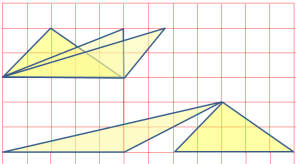One popular way of introducing the negative numbers is through the number line. Most textbooks start with the whole number on the number line and then show to the students that the number is decreasing by 1. From there, the negative numbers are introduced. This seems to be something easy for students to understand but I found out that even if students already know about the existence of negative numbers having used them to represent situations like 3 degrees below zero as -3, they would not think of -1 as the next number at the left of zero when it is presented in the number line. They would suggest another negative number and some will even suggest the number 1, then 2, then so on, thinking that maybe the numbers are mirror images.
Here is an alternative activity that I found effective in introducing the number line and the existence of negative numbers. The purpose of the activity is to introduce the number line, provide students another context where negative numbers can be produced (the first is in the activity on Sorting Situations and the second is in the task Sorting Number Expressions), and get them to reason and make connections. The task looks simple but for students who have not been taught integers or the number line the task was a problem solving activity.

When I asked the class to show their answers on the board, two arrangements were presented. Half of the class presented the first solution and the other half of the students, the second solution. Continue reading “Teaching negative numbers via the numberline with a twist”






